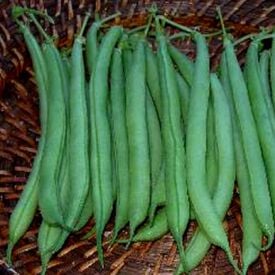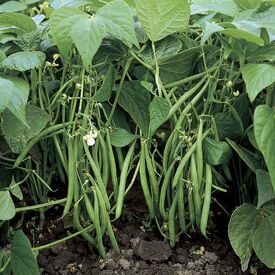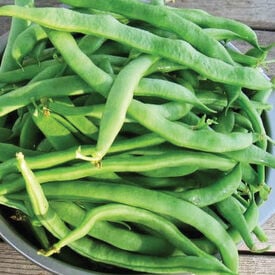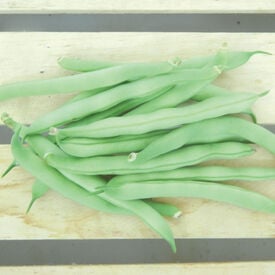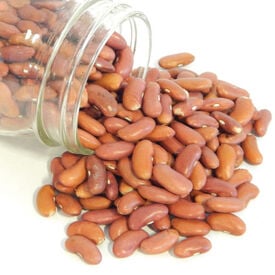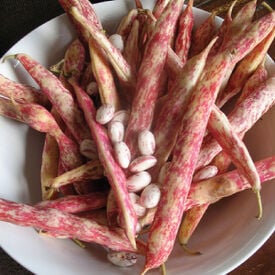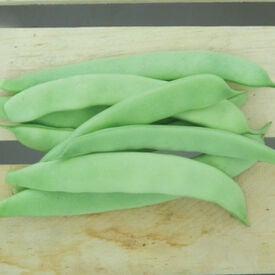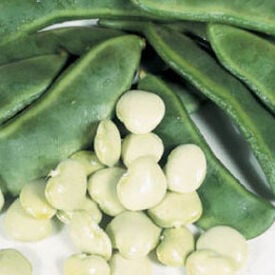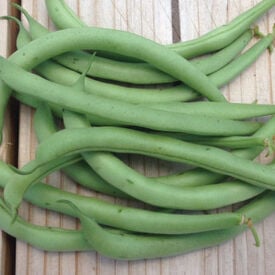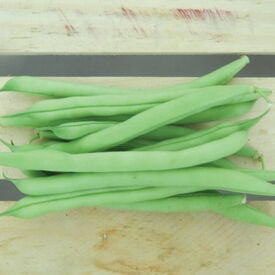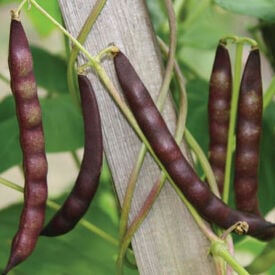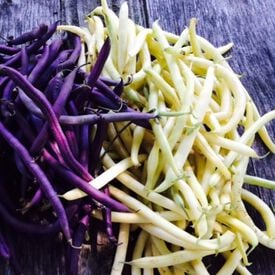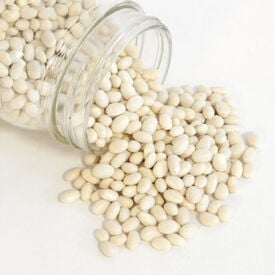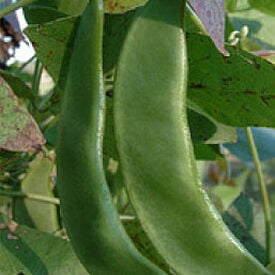Learn More
Strike beans are one of the heaviest yielding bush beans on the market. Continuous setting feature protects grower from stress, better than concentrated set types. Medium green, 5" round pod with good disease tolerance. Excellent flavor that is very popular with commercial growers.
Jameson Bean is a popular and versatile variety of bean known for its exceptional taste and rich history. These beans are classified as a bush bean, which means they grow in a compact, bushy fashion without the need for support structures. Jameson Beans are typically small to medium-sized, oval-shaped, and boast a creamy texture with a slightly nutty and earthy flavor profile. They are a beloved choice for both fresh consumption and canning due to their outstanding taste. With a historical background dating back decades, Jameson Beans have been a favorite among home gardeners and commercial growers alike. They have a relatively short maturity period, typically taking around 50 to 55 days to reach full maturity from the time of planting. The beans themselves are often a vibrant green color, making them visually appealing in a variety of dishes. In terms of growing characteristics, Jameson Beans exhibit good disease resistance, particularly against common bean diseases such as rust and bean common mosaic virus. The yield per row can vary depending on factors such as soil quality and care, but they tend to be productive plants, providing a substantial harvest. It is recommended to space the plants about 2-4 inches apart in rows that are approximately 18-24 inches apart. These beans thrive in well-drained soil and require full sun for optimal growth, making them a reliable choice for both novice and experienced gardeners.
The Kentucky Wonder 125 bean is a wonderful bush bean that is above the others! Kentucky Wonder 125 Bush Bean matures early than most bush beans and produces beans in clusters over a long season. The bush beans’ meaty, medium-green pods are 8 inches and packed with delicious, extra-tasty bean seeds.
Tendergreen Improved is one of the highest yielding beans around. The Tendergreen Improved bean plant is a widely adapted home garden variety. These bean plants will produce some of the highest bean yields you'll ever see. Best eaten fresh.
The Light Red Kidney Bean is a popular kidney bean that has mild bean flavor! Excellent for chili, bean salads, and soups. Exceptional culinary quality, with silky texture and thin skin. Plants grow to medium size that are sturdy and widely adapted. Produce well anywhere in the United States.
The Vermont Cranberry Shell bean is an incredible bean variety that can be used as a snap, shell or dry bean. Cranberry Shell stores exceptionally well. Maroon colored beans are decorated with darker red, cranberry markings. This variety dates back to the 1800s and is well-suited to short-season, cool summer climates.
Roma II beans, also known as Romano beans or Italian flat beans, are a popular variety of green beans known for their exceptional flavor and unique appearance. These beans have a rich history dating back to ancient Rome, where they were cultivated and enjoyed for their culinary versatility. Roma II beans are distinct from traditional green beans due to their flat, wide pods and are favored by many for their tender, meaty texture and delicious taste. The taste of Roma II beans is often described as nutty and slightly sweeter than regular green beans, making them a sought-after choice in various culinary dishes. These beans are typically harvested when they are about 4-6 inches long, ensuring optimal tenderness and flavor. The plants of Roma II beans are known to be vigorous and can reach a height of about 18-24 inches. They have a relatively short maturity period, usually taking around 60 days to reach harvest readiness from the time of planting. The pods of Roma II beans are typically a vibrant green color and can grow to be 5-6 inches long. Roma II beans are prized for their resistance to common bean diseases, including common mosaic virus, rust, and bacterial brown spot, which can help ensure a healthy harvest. When properly cared for, these plants can yield a bountiful crop. For optimal growth, Roma II beans should be spaced about 3-4 inches apart in rows that are 18-24 inches apart. They thrive in well-drained soil and require full sun exposure, making them a great addition to any home garden or farm. Overall, Roma II beans are a delightful and versatile choice for those looking to grow and enjoy fresh, flavorful beans.
Henderson Lima beans, often referred to as Henderson's Bush Beans, are a renowned heirloom variety with a rich history and notable characteristics. Originating in the early 20th century, these beans were developed by the Henderson Seed Company, a notable seed supplier based in the United States. Henderson beans are appreciated for their compact, bushy growth habit, making them well-suited for smaller gardens or container planting. The plants typically reach about 18 to 24 inches in height, which allows for easy management and harvesting without the need for extensive staking or trellising. The beans are characterized by their smooth, green pods and are known for their tender texture and sweet, mild flavor. The pods are generally harvested when they are young and firm, usually in mid to late summer, to ensure the best taste and quality. Henderson beans are valued for their consistent productivity and disease resistance, which contribute to a reliable harvest. With their appealing flavor, compact growth habit, and dependable performance, Henderson beans remain a popular choice among home gardeners seeking a high-quality, easy-to-grow bean variety.
Chivo Blanco beans (Frijol Chivo Blanco) are a cherished heirloom variety native to Mexico, known for their small, white, and slightly oval-shaped beans. These beans are valued for their creamy texture and delicate flavor, making them perfect for a wide range of traditional Mexican dishes such as soups, stews, and frijoles de la olla (beans in a pot). The name "Chivo Blanco" refers to their smooth, pale appearance, and they are often praised for their ability to cook quickly and absorb seasonings well. Grown primarily in the central and southern regions of Mexico, Chivo Blanco beans are resilient to various growing conditions, thriving in both temperate and semi-arid climates. As an open-pollinated variety, they are ideal for sustainable farming and seed-saving, helping to preserve the rich agricultural heritage of Mexico while offering a reliable, nutritious source of protein for many households.
Bayo beans (Frijol Bayo) are a popular heirloom variety in Mexican cuisine, known for their creamy texture and mild, earthy flavor. These small, tan-colored beans with subtle speckling are prized for their versatility, often used in a variety of dishes like soups, stews, and refried beans. Their smooth consistency when cooked makes them ideal for creating hearty, comforting meals, and they hold up well in both traditional Mexican fare and more contemporary recipes. Bayo beans thrive in warm climates with well-drained soil and are particularly appreciated for their drought tolerance and resilience in the field. As an open-pollinated variety, Bayo beans are excellent for sustainable farming practices and seed-saving, allowing farmers and gardeners to preserve this rich agricultural tradition. These beans are not only a staple in many homes but also an essential part of Mexico’s agricultural and culinary heritage.
Contender beans, scientifically known as Phaseolus vulgaris 'Contender,' are a popular variety of green snap beans that have a rich history and are prized by gardeners for their excellent flavor and productivity. Originating from the United States, Contender beans have been a favorite among home gardeners and commercial growers for many decades. This heirloom variety was first introduced in the 1940s and has since become a classic choice for those looking to cultivate delicious and reliable green beans. Contender beans typically produce uniform, straight pods that range in size from 6 to 7 inches (15 to 18 cm) in length. The pods are slender and tender, making them ideal for fresh consumption, canning, or freezing. The plants themselves are compact and bushy, reaching a height of about 18 to 24 inches (45 to 60 cm), which makes them well-suited for smaller garden spaces or container gardening. In terms of maturity, Contender beans are known for their relatively quick growth. They typically reach maturity in approximately 50 to 55 days after planting. These beans thrive in full sun and well-drained soil with good organic matter content. They are relatively easy to grow and require regular watering to maintain consistent soil moisture. Contender beans are a favorite among gardeners for their reliability, versatility, and the delectable taste of their tender green pods.
Provider beans are a popular bush bean variety that has garnered attention for its reliable performance and ease of cultivation. Developed in the United States, Provider beans have a rich history dating back to the mid-20th century, when they were bred for both home gardens and commercial production. These beans are characterized by their compact growth habit, typically reaching about 18 to 24 inches in height, which makes them perfect for small spaces and easy to manage without staking. The pods are smooth and a vibrant green color, generally growing to about 5 to 6 inches long. Known for their excellent flavor and crisp texture, Provider beans are ideal for fresh eating, canning, or freezing. Harvesting is best done when the pods are young and firm, usually in mid to late summer, ensuring the best taste and quality. The plants are vigorous and produce high yields, demonstrating good resistance to common diseases. With their dependable growth, delightful flavor, and adaptability, Provider beans remain a favorite choice for both novice and experienced gardeners.
The Black Turtle Soup bean is very popular Latin favorite, that is also great in Cajun and Creole dishes. A tasty variety that grows upright with black beans inside the pod. Tall bush that keeps the bean pods off the ground.
Python beans are a distinctive and versatile variety of pole beans, celebrated for their unique appearance and robust flavor. Named for their long, slender pods, which can reach up to 23" inches in length, Python beans offer an impressive visual appeal with their vibrant green color and smooth texture. The plants exhibit a vigorous climbing habit, often requiring sturdy trellises or poles for support as they grow to heights of 6 to 8 feet. Python beans are known for their crisp, tender pods and slightly sweet taste, making them an excellent choice for fresh eating, sautéing, or adding to various dishes. They are also prized for their resilience and adaptability, thriving in a range of soil types and weather conditions. With a maturity period of about 70 to 80 days, Python beans provide a reliable and attractive harvest, enhancing both the beauty and flavor of any vegetable garden.
The Mardi Gras Blend is almost too pretty to eat! These fun bright yellow and purple semi flat bean pods are a favorite among home chefs. The Mardi Gras Blend sets a heavy crop of delicious nutty beans. These organic heirlooms are a fun way to get beneficial nutrients.
Navy beans, scientifically known as Phaseolus vulgaris, are small, oval-shaped beans that are a popular and versatile member of the legume family. They are often referred to as navy beans due to their association with the United States Navy, where they were a staple food for sailors in the 19th century. These beans have a rich history dating back to ancient times when they were cultivated by indigenous peoples in the Americas. They were later introduced to Europe by Spanish explorers and became an essential part of global cuisine. Navy beans have a mild, nutty flavor and a smooth, creamy texture when cooked. They are known for their ability to absorb the flavors of the ingredients they are cooked with, making them a favorite in soups, stews, and baked bean dishes. These beans are typically small, about half an inch in length, and are usually white or off-white in color, although there are variations with speckled or colored coats. In terms of plant characteristics, navy bean plants are relatively compact, reaching a height of about 18 to 24 inches. They have a bushy growth habit and produce small, white or lavender flowers before developing pods that contain the beans. Navy beans typically take around 80 to 90 days to reach maturity, making them a relatively quick-growing crop. They thrive in well-drained soil with good moisture retention and prefer full sun for optimal growth. Adequate spacing and support may be needed to ensure healthy plant development, and they are generally grown as annuals in most regions.
King of the Garden beans are a classic heirloom variety cherished for their robust growth and exceptional flavor. Developed in the early 20th century, this variety has a rich history in American gardens, particularly noted for its productivity. King of the Garden lima beans are characterized by their vigorous pole growth habit, often reaching heights of 6 to 8 feet, making them ideal for trellises or fences. The pods are typically long, smooth, and bright green, growing up to 7 inches in length. Known for their rich, buttery flavor and tender texture, these beans are perfect for fresh eating, canning, or freezing. Harvesting is best done in mid-summer to early fall when the pods are still young and firm to ensure optimal taste and quality. The plants are not only prolific but also exhibit good disease resistance, making them a reliable choice for gardeners. With their delightful flavor, impressive yield, and historical significance, King of the Garden beans continue to be a favorite among home gardeners and culinary enthusiasts alike.
Amarillo beans (Frijol Amarillo) are a beloved heirloom variety in Mexican cuisine, known for their golden-yellow color and slightly sweet, earthy flavor. These beans are medium-sized, with a smooth texture that makes them perfect for use in a variety of traditional dishes, such as stews, soups, and frijoles de la olla. Their subtle flavor and creamy consistency when cooked make them a versatile ingredient in both savory and vegetarian meals. Grown primarily in the central and southern regions of Mexico, Amarillo beans are well-suited to a range of climates and soil types, offering resilience and a reliable yield. As an open-pollinated variety, they are ideal for sustainable farming practices and seed-saving, ensuring that this flavorful and nutritious bean continues to play an essential role in both Mexican agriculture and cuisine.
